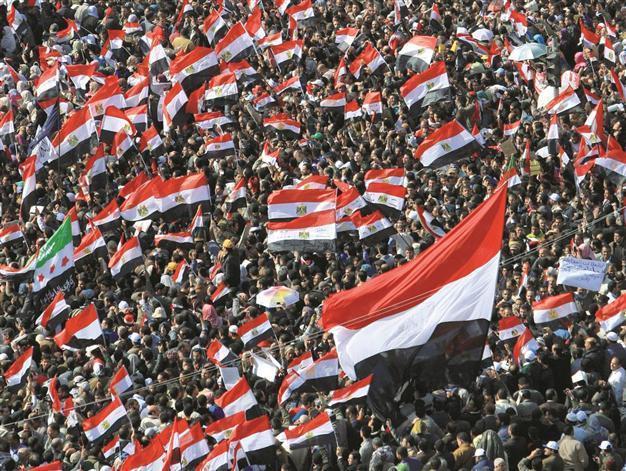Arab Spring blossoming in cinema
EMRAH GÜLER Hürriyet Daily News

Festivals in Turkey were quick to pick up the trend, incorporating sections into their programs as well. The festivals showed many films from Arab world and praise the Arab revolution in cinema. AFP photo
There’s something intrinsically ironic about the nature of Arab Spring, about the relationship between how the West looks down on the Arab world for lagging behind in civilization, and how the Arab world has popularized a movement for freedom with the use of new media tools, the epitome of a new age in Western civilization.When Arab communities successfully used social media, mobile phones and amateur videos for a revolutionary wave that would leave its mark on history, intellectuals worldwide celebrated this new, powerful way to communicate, organize and, eventually, stage uprisings.
Another celebration of the Arab Spring was soon seen in the establishment of cinema. First, feature films, shorts and documentaries on the civil resistance among Arab societies began gracing festival programs. Later, examples from the cinemas of Egypt, Syria, Tunisia, and even Turkey, long preceding the Arab Spring, started becoming integral parts of film festivals, as well as hot topics in film discussions.
Major film festivals from Venice to Berlin included a rich selection of films into their programs that chronicled the revolutions across the Arab world or films that were simply made by those countries that had made headlines in the last year.
Festivals in Turkey were quick to pick up the trend, incorporating sections into their programs as well. Last December’s Festival on Wheels featured a section called “Spring is Revolutionary,” showing an array of shorts and documentaries on the revolutions in Egypt and Tunisia, and on the role of social media in the spread of the Arab Spring. Always sensitive to issues of freedom, last February’s !f International Independent Film Festival’s People Power section blared, “We are the 99 percent.” The section brought together examples on civil disobedience, rebellion and opposition from around the world, one of the highlights being “Tahrir 2011: The Good, the Bad and the Politician,” three Egyptian directors’ look on the revolution that started in Cairo’s Tahrir Square.
And in early March, the International Filmmor Women’s Film Festival devoted a section to the female directors of Tunisia. Now, the Ankara International Film Festival, still continuing its run, is running a selection of films from Egypt under the section “Bread, Change and Social Justice,” which features films directly related to the Arab Spring and others preceding the revolutions.
Stories of inspiration
“Tahrir 2011: The Good, the Bad and the Politician,” by filmmakers Tamer Ezzat, Ayten Amin and Amr Salama, is a good example to the shared nature and narrative of the films on the Arab Spring. The Egyptian revolution here is the focal point, examining the days following Jan. 25, 2011, the day when the demonstrations turned into a full-fledged revolution.
Interviews with prominent figures, politicians and civil leaders are a common theme. But more common in these films is interviews with and profiles of those that inspired change, those who contributed to the movements with their unique stories and personal journeys that eventually became something bigger than they had set out to become.
On a similar note is Stefano Savona’s “Tahrir: Liberation Square,” another chronicle of the two weeks after Jan. 25 that follows three young men who were part of the thousands of Egyptians who took to the streets to overthrow Hosni Mubarak’s regime. Yet another example is Egyptian filmmaker Emad Maher’s “Revolution of Youth,” which is about a family of three generations in Alexandria and how they take the historical changes in their country as they unfold.
Images and hashtags of revolution
Director and writer Nadia El Fani’s “Neither Allah nor Master” (Laïcité Inch’Allah!) is a powerful look on the Zine El Abidine Ben Ali regime months before the Tunisian revolution and the revolution as it broke in the last months of 2010. Syrian director Ammar Al Beik’s short “The Sun Incubator” (Hadinat Al Shams) moves from a family getting ready to demonstrate in Egypt in early 2011 to the spring when Syrian Hamza al-Khateeb is shot and tortured, kick-starting the Syrian uprising.
Then there are the films that take a direct look at the role of social media in the Arab Spring. As evident from its title, “Images of Revolution,” by Qatar filmmaker Ibrahim Hamdan, takes a look at the stories behind the iconic images of the uprisings that have come to symbolize the Arab Spring, the photos and videos that fueled the revolutionary wave through Twitter and Facebook.
Carolina Popolani’s “Cairo Downtown” of 2009 is an in-depth look at the Egyptian bloggers who formed part of the organized underground long before the mass protests that eventually led to the fall of Mubarak. The film takes a look at how bloggers used Internet activism as a political weapon and a powerful tool to organize.
Then, of course, there is the other way around. Writing for The Guardian, Sukhdev Sandhu cites Iranian film scholar Hamid Dabashi to make a point on how the roots of the Arab Spring lies in cinema: “If you want to understand the emotive universe from which the Arab spring arose, cinema is a good place to start. Look at a film like Elia Suleiman’s ‘Divine Intervention’: there, the director spits out an apricot pit at an Israeli tank and blows it up. The scene is both fantasy and prophecy.” As for the films screened under dozens of sections in film festivals devoted to the Arab Spring, they are neither fantasy nor prophecy.
















